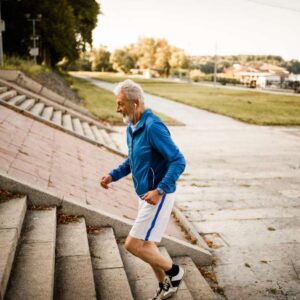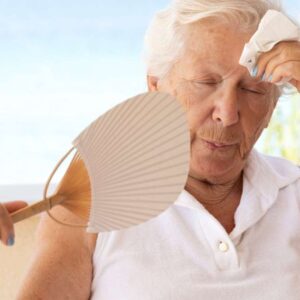
PREDICT Stroke with This “Triple Threat” Method
Dear Living Well Daily Reader,
Strokes are kind of like earthquakes: no one can predict them.
Sure, we know the risk factors for them, like high blood pressure, clogged arteries, or obesity.
But we’ve never quite nailed down how to stop strokes before they happen.
That is, until now.
Recently, researchers have uncovered THREE early warning signs of stroke.
And knowing how to identify this “triple threat” can SAVE your life.
A recent study from The Lancet Psychiatry found that fatigue, apathy, and delirium could be signs of a stroke.
You see, one cause of “mini-strokes” is cerebral small-vessel disease (CSVD). This condition occurs when the smaller blood vessels in your brain become damaged.
CSVDs are tiny strokes that happen in the smallest of blood vessels in the brain. Not only are CSVDs tied to stokes, but they are a major cause of vascular dementia (a type of dementia caused by poor circulation).
These early small strokes are signs that the blood vessels in someone’s brain are fragile, and it’s only a matter of time until a larger blood vessel fails and causes a massive stroke.
The problem is most people don’t recognize the symptoms of CSVDs – until NOW.
Researchers discovered this when they analyzed information from 81 studies totaling 21,730 stroke patients.
When they compared the records and brain scans, they found something strange. Those who’d experienced feelings of apathy, extra fatigue, or confusion and delirium had more white matter hyperintensity (WMH).
These are lesions that show up in the brains of seniors and high blood pressure patients. And they also can signal stroke damage.
It appeared that these feelings patients were experiencing were warning signs that a small stroke had happened… and that a larger—and perhaps deadlier— one could be on the way.
If someone you love has a sudden change in mood and feels tired all the time, talk to their doctor about the possibility of CSVD. To many doctors, CSVDs are too often dismissed as depression or dementia.
Because there’s no absolute way to find CSVDs unless you are already getting a CT scan or MRI, it’s important to make sure your loved one’s doctor is aware of them.
Here are the most common symptoms with someone who has had a stroke:
- Face drooping. To see this more clearly, you can ask the person to smile and see if one side is drooping. One side of the face may also be numb, and their smile may appear uneven.
- Arm weakness. The person will have weakness or numbness on one side.
- Speech difficulty. People having a stroke may slur their speech or have trouble speaking at all. Speech may be hard to understand.
If you think someone is having ANY of these symptoms, you should get them to care as soon as possible.
P.S. Doctors have been recommending this “harmless” stroke prevention tip for years, but it could actually RAISE your stroke risk by a whopping 37 percent. Find out what it is right here.
Written By Dr. Scott Olson, ND
Nearly 25 years ago, failed mainstream medical treatments left Dr. Olson in constant pain – and his health in ruins. And that’s when he did something REVOLUTIONARY. He began his career in medicine – and dedicated his life to uncovering the true, underlying causes of disease.
Through his innovative medical practices in Tennessee and Colorado, Dr. Olson has helped cure countless seniors from across America of arthritis… heart disease… diabetes… and even cancer. All without risky prescription drugs or painful surgeries.
View More Free Articles
A New Reason to Ditch Processed Junk
If you’ve ever walked the inside aisles of your local grocery store and thought, “This is all just junk,” your instincts were spot on. A new study published in the journal Thorax just added another red flag to the list of dangers linked to ultra-processed food—a 41 percent higher risk of lung cancer. That’s right....
When Being Winded on Stairs Is Serious (And When It Isn’t)
I had an athlete visit me recently because he experienced shortness of breath while climbing stairs. He is in great shape, so he was worried about what it might mean. “Doc,” he said, “I run five miles three times a week. Why am I huffing and puffing after two flights of stairs?” His concern is...
Study EXPOSES Hidden Danger Lurking in Your Car
We think of our homes and cars as safe havens. But according to a startling new study, they may be flooding your lungs with microscopic plastic particles—every single day. Researchers in France recently found that adults inhale an average of 68,000 microplastic particles daily from indoor air alone. To put that in perspective, that’s about...
Mailbag: Is Modern Food Making You Snore?
“What can cause snoring, and is there a way to correct this issue?” —Seeking Silence Hi Seeking, Snoring happens when the soft tissues in your throat relax and vibrate as air passes through during sleep. While several factors can cause snoring—from sleep position to nasal congestion—I want to share one trigger that might surprise you....
Simple Food Swap SLASHES Dementia Risk 28%
Let’s be honest… who would jump at the chance to cut their dementia risk by 28 percent. And no, you don’t need to run marathons, survive on broccoli, or learn to play the zither (whatever that is) to make it happen. All it takes is one easy swap—something that’s probably already in your refrigerator. Researchers...
This SMART Floss Exposes Hidden Health Danger
Scientists have created dental floss that doesn’t just clean between your teeth—it also tracks your stress while you’re flossing. Now, I know what you’re thinking… “Great—now even flossing is going to stress me out by telling me how stressed I am.” But this fascinating new tool from Tufts University could be a game-changer for understanding...
Is This "Safe" Sweetener Damaging Your Brain?
The headlines are alarming… “Popular Sugar Substitute Linked to Brain Cell Damage” and “Erythritol Could Damage Critical Brain Barrier” are just two of the dozens I’ve spotted recently. But before you toss every sugar-free product in your pantry, let’s take a closer look at what this study actually shows—and what it doesn’t. The latest research...
This Summer Threat Could SPIKE Your Blood Sugar
Picture this… It’s another scorching hot summer day. You crank up the air conditioning while watching the weather forecast, which predicts yet another “record-breaking” heat wave. It’s starting to feel like just another miserably uncomfortable summer. But what you might not realize is that—if you have diabetes—those rising temps could do far more damage to...
Move Over Yogurt—5 Foods That Pack MORE Probiotics
Let’s talk about your gut. The microbiome is the collection of trillions of bacteria and other tiny organisms that live in and on your body—especially in your gut—and help keep you healthy. I’ve written often about how vital it is to maintain a healthy microbiome. And you might have dutifully added yogurt to your shopping...
Is Your Heart Older Than YOU?
Maybe you feel young for your age. Good energy, decent sleep, eating your veggies. But what if I told you your heart might be a decade older than the rest of you? That’s exactly what researchers at Northwestern University found in a new study published in JAMA Cardiology. The average American woman’s heart is about...









